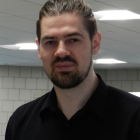Abstract:
The dynamics of excited states is critically important in many materials such as photovoltaic solar energy harvesters, photocatalysts, or photo-actuated molecular switches. Electron-hole recombination, interfacial charge transfer, or nonradiative excitation energy relaxation, all require accounting for nonadiabatic (NA) effects. Computational modeling of NA and quantum dynamics (NA/QD) at the atomistic level can provide valuable insights into these processes and help design new routes for improving materials' efficiencies, but also poses a great challenge to the scientific community due to its taxing computational complexity. The demands for modeling NA/QD in periodic solids and nanoclusters stimulated the development of numerous approximations and the wide adoption of simplified computational schemes. However, the quality of such schemes remains largely unclear, leaving one questioning about their applicability. It is often unclear how one scheme compares with another in a zoo of many ad hoc approaches.
Over the past few years, my group has been developing a modular open-source Libra software.1 We utilized it as a framework for developing new practical tools for NA/QD, assessing the variety of existing approximations, and conducting the applied studies of NA dynamics in various types of nanoscale and condensed-matter systems and materials. In this seminar, I will first overview some of these new methodology developments, including simple approaches for accounting for the nuclear quantum effects,2 solving the phase consistency problem in computing nonadiabatic couplings,3 and tracking the states’ identities.4 In the second part of my talk, I will focus on the assessment of the electronic structure methods as used in NA/QD calculations in nanoscale and condensed matter systems. In particular, I will highlight our recently developed scheme to account for many-body effects in modeling NA/QD in nanocrystals5 and periodic solids. I will discuss the role of the many-body treatment of excited states in Si and CdSe nanoclusters and bulk lead halide perovskites. Time-allowing, the qualitative trends in computed NA/QD as the function of the density functional choice6 and inclusion of relativistic effects will be discussed.7
References:
(1) Akimov, A. V. Libra: An Open-Source “Methodology Discovery” Library for Quantum and Classical Dynamics Simulations. J. Comput. Chem. 2016, 37, 1626–1649. https://doi.org/10.1002/jcc.24367.
(2) Smith, B.; Akimov, A. V. Entangled Trajectories Hamiltonian Dynamics for Treating Quantum Nuclear Effects. J. Chem. Phys. 2018, 148, 144106. https://doi.org/10.1063/1.5022573.
(3) Akimov, A. V. A Simple Phase Correction Makes a Big Difference in Nonadiabatic Molecular Dynamics. J. Phys. Chem. Lett. 2018, 9, 6096–6102. https://doi.org/10.1021/acs.jpclett.8b02826.
(4) Temen, S.; Akimov, A. V. A Simple Solution to Trivial Crossings: A Stochastic State Tracking Approach. J. Phys. Chem. Lett. 2021, 12, 850–860. https://doi.org/10.1021/acs.jpclett.0c03428.
(5) Smith, B. A.; Shakiba, M.; Akimov, A. V. Nonadiabatic Dynamics in Si and CdSe Nanocluster: Many-Body vs. Single-Particle Treatment of Excited States. J. Chem. Theory Comput. 2021, 17, 678–693.
(6) Lin, Y.; Akimov, A. V. Dependence of Nonadiabatic Couplings with Kohn–Sham Orbitals on the Choice of Density Functional: Pure vs Hybrid. J. Phys. Chem. A 2016, 120, 9028–9041. https://doi.org/10.1021/acs.jpca.6b09660.
(7) Li, W.; Zhou, L.; Prezhdo, O. V.; Akimov, A. V. Spin–Orbit Interactions Greatly Accelerate Nonradiative Dynamics in Lead Halide Perovskites. ACS Energy Lett. 2018, 3, 2159–2166. https://doi.org/10.1021/acsenergylett.8b01226.
Speaker:
Institution:
Location:

